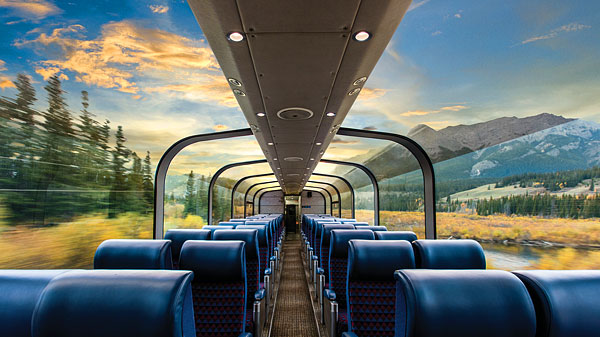For the full article, please find the latest issue of Gafencu’s print magazine or the PDF version on the Gafencu app. Download the app from the Google Play Store or Apple App Store.

Canada High: The Rockies by rail is an on-line experience like no other
When it comes to regions of natural beauty, few parts of the world can compare to the awe-inspiring wonder of the Rockies. North America’s largest mountain range, it stretches out across some 4,828km, all the way from New Mexico – the southern US state – to British Columbia, Canada’s westernmost province.
In the land of the Canucks, the mountains occupy a space of some 180,000sq.km, expanding out across four national and three provincial parks. With such a vast array of high-altitude wonder to be explored, there really is only one way to appreciate the full majesty of these mountains. While it’s a route that’s been in place for more than a century, when it comes to savouring the real Rockies, the Canadian railway service just can’t be beaten.

For almost 100 years after Canada was first settled, it was considered faster and easier to sail to the depths of South America and back than to chance crossing these mighty peaks. Looking to eliminate these mammoth marine marathons, the Canadian government then set about considering a bold plan for a railway system that would cross the Rocky Mountains, connecting British Columbia to the then-capital of Kingston, Ontario.
In 1881, they turned to making that plan a reality, and, ever since then, the Canadian Pacific Railway has played a central role in unifying the country and channelling its development. Perhaps not entirely unexpectedly, completing such a bold and unprecedented project came at quite a cost, not all of it financial.

Between 1881 and 1884, some 17,000 Chinese labourers were hired to work on the line. Typically, their wages were considerably lower than their white counterparts, while the dangers they were exposed to were far greater. At best, they slept in freezing boxcars and received no medical care, at worst, they fell victim to haphazard blasting operations or were left to perish below one of the all-too-frequent landslides that dogged the construction process.
Such harsh realities, though, are hard to reconcile with the modern-day Rockies, which are now scaled by countless fun and fitness seekers every year. Across their vast extent, they are home to luxury ski resorts, national parks and the kind of pristine lakes beloved of water sports enthusiasts. Above all, of course, they remain the ideal sanctuary for stressed-out city dwellers.

Indeed, if you are really are keen to explore the Canadian Rockies – while keeping your carbon footprint to the minimum – it would be wise to get one of the country’s leading train tourism schedulers on board, such as Vancouver-headquartered Rocky Mountaineer. The company offers a raft of rail experiences, ranging from four- to 14-night journeys, which collectively span Alberta and British Columbia, Canada’s two westernmost provinces. Along the way, you can visit the towns and parks of Banff, Jasper, Whistler and Kamloops, before ending your journey in Vancouver.
As Canada’s only truly luxury train service, travel is limited to the daylight hours, with bookings taken from the beginning of April to the end of October. Throughout your journey, there are plenty of opportunities to disembark and stay in one of the many luxurious hotels that line the route, such as the Fairmont Jasper Lodge Park or the Post Hotel in Lake Louise.
Once back aboard the train, though, you can just sit back, relax, recline your chair and enjoy the views. Most services even offer a beguiling outdoor viewing platform, a truly breathtaking way to take in the passing landscape.

Whenever and wherever you choose to hop off the Mountaineer, you are assured of one thing – a bracing blast of Canada’s famously fresh air. Despite the temperature in Alberta hovering around the 20-25oC mark in the summer months – and British Columbia being known to top 30oC – the season is notoriously fickle, with a shiver or two par for the course at the higher altitudes. With that in mind, it’s best to stow a jacket beside your shorts and sunscreen.
While the train’s dining car offers a surprisingly high standard of cuisine, it’s still worth scheduling a stop at one or two of the finer route-side eateries, most particularly the Sky Bistro. Set squarely on the peak of Banff’s Sulphur Mountain, this offers fabulous local cuisine, a wide selection of Canadian beers and, of course, glorious views. For those bold enough for a yet more rugged encounter with the Great Canadian outdoors, there’s always the option of pitching a tent and truly immersing yourself in the wilderness.

Whatever option you choose, before heading back to the train for the last leg of your journey, there are a couple of quintessentially Canadian traditions you just have to observe if you want to boast that you have truly ‘done’ the country. At the very least, you need to sneak a shot of a beaver (from a safe distance, of course) and wave to a passing Mountie. Completists may also want to end at least one sentence with ‘eh’ whether it’s truly merited or not.
As you pull back into the station, though, don’t expect this to be the end of the line for you and the country. There’s something about Canada – its people, its environment, its landscapes and its way of life – that sees many yearning to return time and again. And when you do, you’re assured of a welcome that’s as enchanting and as enduring as the Rockies themselves.
Text: Bailey Atkinson







